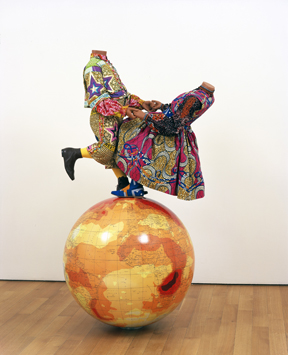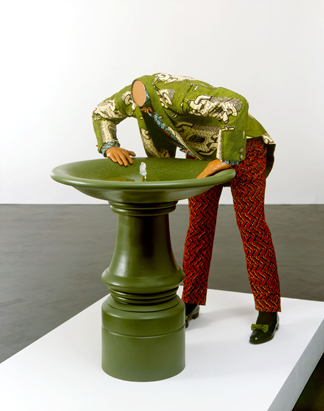Postcolonial provocateur: an ironic look at cultural identity at African Art
Yinka Shonibare, one of this generation’s most celebrated artists, is the focus of a new exhibition at the Museum of African Art. On view through March 7, 2010, the exhibition features 21 dramatic paintings, photographic series, films and sculptural tableaux to portray the complexities of cultural identity. “Yinka Shonibare MBE” is the most comprehensive exhibition to date of works by this 47-year-old London-based artist.
Photo: (Click on thumbnail for fullsize image.) Detail from “Black Gold I” (2006), the first in a set of paintings that explore the complex politics and economics of oil and connect Shonibare’s early explorations of themes of wealth, class and privilege in his art with contemporary global issues.
The works in Shonibare’s exhibition consider contemporary African identity and its relationship to historic colonial practices and neo-colonial policies through painting, sculpture, installation and moving image. “Shonibare is most widely recognized for the elaborate sculptural tableaux he creates of richly costumed, headless mannequins,” Karen Milbourne, African Art Museum curator, explains. “These costumes are made from fabrics inspired by Indonesian batiks, but manufactured in Europe and sold in West Africa. Today, these vibrantly patterned textiles are closely associated with African identity, and yet they also signal the entangled relations that unite peoples and cultures around the world.”
“Scramble for Africa” (2003) is a pivotal work for Shonibare in its exploration of late Victorian England and its territorial expansion into Africa during the 1880s. The “scramble” for Africa by leading European and world powers resulted in the carving up of the continent, an act that was formalized at the Berlin Conference of 1884–85. Shonibare’s work depicts this historic gathering, showing various statesmen huddled around a table with a large map of Africa, eagerly staking their claims. In Shonibare’s interpretation the heads of state are characteristically headless—and equally mindless in their hunger for what Belgian King Leopold II called “a slice of this magnificent cake.”
“These works are a testament to the contemporary understanding of colonial and post-colonial African identity,” said Rachel Kent, senior curator at the Museum of Modern Art in Sydney, Australia. “Never before have so many pieces of Shonibare’s work come together for public view.”
“The exhibit reflects the artificial construct of culture. It’s not about authentic African experience or the authentic British experience—it lies somewhere both between and separate,” Shonibare says.
“Globe Children” ( 2008) is part of a new body of work by Shonibare exploring the theme of climate change. Two children balance precariously on a globe of the world; its surface shaded with colors that indicate zones of warming or environmental shift. This information is based upon an infrared heat map of the world that indicates those regions currently affected by temperature changes.
Born in England in 1962 and raised in Nigeria, Shonibare currently lives and works in London, where he has gained international attention by exploring issues of race and class through a range of media that includes sculpture, painting, photography and installation art. In 2005, he was awarded Member of the Order of the British Empire by Queen Elizabeth II.
As with Shonibare’s sculptural pieces, the artist’s photographic works draw upon the Victorian era, but here the artist manipulates expectations by inserting himself into the scenes. Most recently, Shonibare has begun to work with moving images and he has created two cinematic works, “Un Ballo in Maschera” and “Odile and Odette,” in which he plays with the notions of black and white imbedded in Tchaikovsky’s “Swan Lake.” The Washington Ballet is choreographing a new piece, to be performed by South African rising star Andile Ndlovu, that will debut at the museum Feb. 6, 2010.
Shonibare has received numerous awards, including Barclays’ “Young Artists Award” (1992) and the Paul Hamlyn Visual Arts Award (1998), and was short-listed for the Citibank Photography Prize (1999). He received an Honorable Mention at the Venice Biennale (2001) and was short-listed for the celebrated Turner Prize. Shonibare was also recently selected for the Fourth Plinth in Trafalgar Square (2008). His works can be found in the permanent collections of the Art Institute of Chicago, Walker Art Center, The Tate Modern and the National Museum of African Art.
“Headless Man Trying to Drink” (2005) is Shonibare’s only “animated” sculpture to date, featuring a water pump and running water. This sculpture presents an incongruous situation—a man who is headless trying to drink from a water fountain. The absurdity of this scenario is reinforced by the patterning of the man’s costume, which features the doubled motif of an abundantly flowing tap and water glass. Shonibare typically presents his sculptural figures minus their heads. In doing so, he makes playful reference to the French Revolution and the beheading of members of the ruling elite. The absence of heads also removes references to individual or racial identity in his figures. The man’s inability to drink from the tap is particularly ironic in the present era. Water shortages, drought and climatic shifts have affected various parts of the world and some environmentalists suggest the future wars will be fought over water, not land.
“Yinka Shonibare MBE” was organized and toured by the Museum of Contemporary Art in Sydney. Click here to visit the online exhibition. A behinds-the-scenes blog chronicles the installation of the exhibition.
Posted: 12 November 2009
- Categories:







